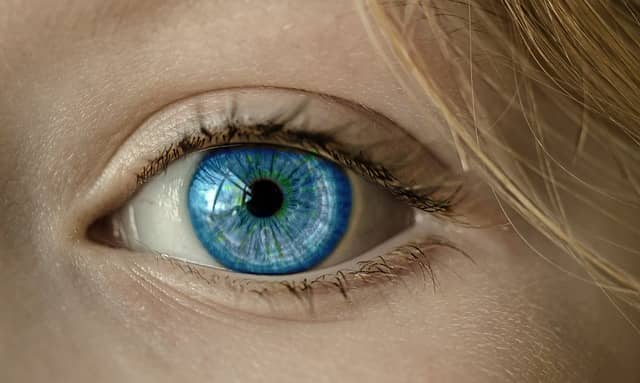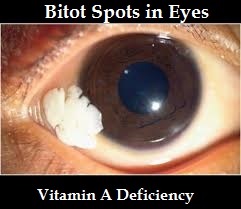BITOT SPOTS: A VISIBLE SIGN OF VITAMIN A DEFICIENCY CAN BE CURED THROUGH 3 SUPER FOOD CHOICES

Bitot spots are a visible sign of vitamin A deficiency. Bitot spots are common nutritional disorder that affects millions of people worldwide, particularly in developing countries.
Bitot spots are small, foamy, or bubbly white patches that appear on the white part of the eye (the conjunctiva). Bitot spot are a telltale indicator that the body is not getting enough of this essential nutrient.
Understanding what Bitot spots are, what causes them, and how to prevent and treat them is crucial for maintaining eye health and overall wellbeing.
What Are Bitot Spots?
Bitot spots are named after the French ophthalmologist Stéphen Bitot, who first described them in 1863. These lesions typically appear as a triangular or wedge-shaped white or gray-white deposit on the conjunctiva, the clear tissue that covers the white part of the eye. They are usually seen in the temporal (outer) quadrant of the eye, near the edge of the cornea.

Bitot spots are a classic sign of xerophthalmia, the clinical term for dry eye disease caused by vitamin A deficiency. As the body lacks sufficient vitamin A, the conjunctiva and cornea become dry, leading to these foamy, bubbling patches.
In severe cases, Bitot spots can progress to more serious eye problems, such as corneal ulceration and blindness.
What are causes of Bitot Spots?
Vitamin A is an essential nutrient that plays a crucial role in maintaining healthy vision, immune function, and skin integrity. It is primarily obtained through the diet, either as preformed vitamin A (retinol) from animal sources or as provitamin A carotenoids, such as beta-carotene, from plant-based foods.
The primary cause of Bitot spots is a deficiency in vitamin A. This can occur due to several other factors too, including:
Inadequate dietary intake
A diet lacking in vitamin A-rich foods, such as liver, egg yolks, dairy products, and orange and green leafy vegetables, can lead to a deficiency over time.
Mal-absorption disorders
Conditions that impair the body’s ability to absorb and utilize vitamin A, such as celiac disease, Crohn’s disease, or cystic fibrosis, can contribute to Bitot spots.
Increased vitamin A requirements
Certain life stages or health conditions, such as pregnancy, lactation, and severe infections, can increase the body’s demand for vitamin A, leading to a relative deficiency.
Liver disease
Chronic liver conditions can impair the storage and release of vitamin A, making it less available for the body’s needs.
Genetic factors
In rare cases, genetic disorders that affect vitamin A metabolism may predispose individuals to developing Bitot spots.
What are symptoms and diagnosis of Bitot Spots?
In addition to the characteristic white, foamy patches on the conjunctiva, individuals with Bitot spots may experience other symptoms of vitamin A deficiency, such as:
- Dry, rough skin
- Acute Night blindness
- Vision problems especially in dim lights
- More vulnerable to catch infections especially infections of digestive and respiratory systems
- Slow wound healing
To diagnose such spots, an eye examination by an ophthalmologist or optometrist is typically the first step. They will use a slit lamp to closely inspect the eye and identify the distinctive lesions. In some cases, additional tests, such as blood work to measure serum vitamin A levels, may be conducted to confirm the diagnosis and rule out other underlying conditions.
What are Preventions of Bitot Spots?
The prevention of Bitot spots revolve around addressing the underlying vitamin A deficiency.
The best way to prevent is to maintain a balanced, nutrient-rich diet that includes adequate amounts of vitamin A. Good sources of this essential nutrient include:
Animal-based foods
Liver, eggs, dairy products (milk, cheese, yogurt)
Orange-colored fruits and vegetables
Carrots, sweet potatoes, pumpkin, mango, papaya
Green leafy vegetables
Spinach, kale, collard greens, broccoli
In areas where vitamin A deficiency is prevalent, public health programs may implement supplementation initiatives, such as providing vitamin A capsules or fortifying staple foods with the nutrient.
What are the treatments of Bitot spots?
If such spots are diagnosed, the primary treatment approach is to address the vitamin A deficiency. This typically involves:
Oral vitamin A supplementation:
Healthcare providers may prescribe high-dose vitamin A supplements, usually in the form of retinol or beta-carotene, to rapidly replenish the body’s stores.
Dietary modifications:
Patients are encouraged to increase their intake of vitamin A-rich foods, such as those mentioned in the prevention section.
Addressing underlying conditions:
If the Bitot spots are associated with a mal-absorption disorder or other medical condition, treating the underlying cause can help improve vitamin A levels.
In most cases, Bitot spots will gradually fade and disappear as the vitamin A deficiency is corrected. However, it’s important to note that severe or prolonged vitamin A deficiency can lead to more serious eye problems, such as corneal ulceration and blindness, which require prompt medical attention.
What are precautions and considerations regarding Bitot spots?
While vitamin A is essential for eye health and overall wellbeing, it’s important to take certain precautions when it comes to such white spots and vitamin A supplementation:
Dosage
Vitamin A supplements should be taken at the recommended dosages, as excessive intake can lead to toxicity and adverse effects, such as liver damage, bone pain, and hair loss.
Interactions
Certain medications, such as some cholesterol-lowering drugs and retinoids used for skin conditions, can interact with vitamin A supplements. Patients should consult their healthcare provider before starting any supplementation.
Pregnancy and breastfeeding
Pregnant and breastfeeding women have specific vitamin A requirements and should only take supplements under the guidance of their healthcare provider.
Underlying conditions
Individuals with liver disease, kidney disease, or other chronic health conditions may need specialized care and monitoring when it comes to vitamin A supplementation.
Monitoring and follow-up
Patients with such spots should undergo regular eye exams and blood tests to monitor their vitamin A levels and ensure the condition is resolving.
By understanding the causes, symptoms, and proper management of Bitot spots, individuals can take proactive steps to maintain eye health and prevent the potentially serious consequences of vitamin A deficiency.
Conclusions
Bitot spots are small white and foamy patches inside the white part of the eye. It primarily caused due to the deficiency of vitamin A. However, there are some other identified reasons of it.
It could disappear by itself as and when the deficiency of vitamin A over. If the deficiency of vitamin A remains intact so it may leads towards some other serious illnesses including ulceration and blindness.
Balanced and nutritional diet can play an effective role in addressing the issue. Poultry food, eggs, yogurt, potatoes, papaya, mango, broccoli, kale and spinach along with some other food options can help in maintaining the vitamin A levels at required and optimal levels.
FAQs
What are Bitot spots?
Bitot spots are small, foamy, or bubbly white patches that appear on the white part of the eye (the conjunctiva).
What is the reason of Bitot spots?
Primarily its due to Vitamin A deficiency
How to prevent Bitot spots?
Through balanced and nutritional diet intake and through necessary medical treatment.







👍